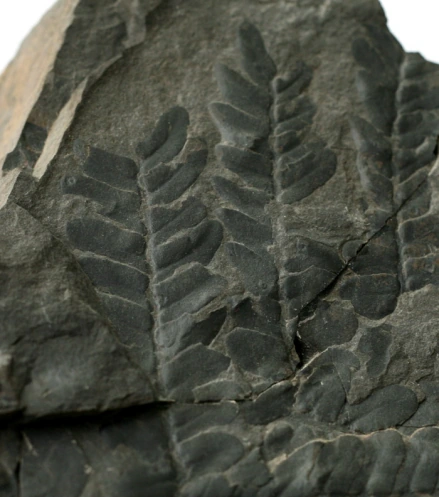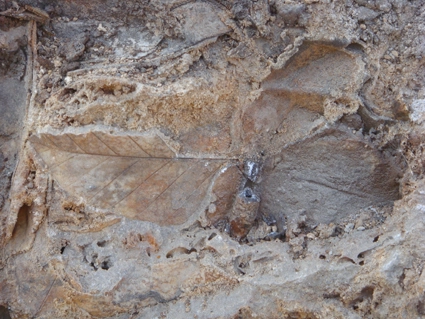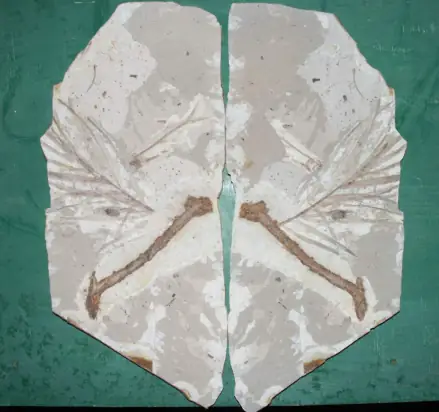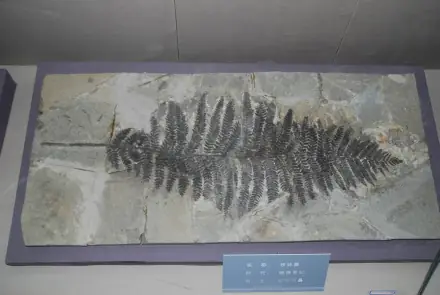Plant fossils are a general term for all kinds of plant fossils. The earliest life in geological history was plants. The most primitive blue algae and fungi fossils were found in the Archean strata 3.5 billion years ago. The Archean and early Proterozoic were the era of primitive fungi and algae. The Proterozoic Middle Lang to Ordovician was the era of the prosperity of marine algae and plants. The Silurian to Carboniferous period was the era of the prosperity of terrestrial spore plants. The Permian to Jurassic period was the era of the prosperity of gymnosperms. The Cretaceous and Cenozoic were the eras of the prosperity of angiosperms. Plant fossils are the main symbols for dividing and restoring the ancient continents, ancient climates and plant geographical divisions in geological periods. Various types of ancient plants themselves also participated in mineralization and diagenesis. For example, the formation of sedimentary iron ore in the Archean is related to the activity of iron bacteria; various algae can form reef limestone, algal coal, diatomaceous earth, etc.; lower plants are related to the formation of petroleum and oil shale; higher plants are the material basis for the formation of coal seams in various historical periods. In April 2022, the Mount Everest expedition discovered 15 million-year-old Himalayan plant fossils

Concept
Simply put, fossils are the remains or traces of organisms that lived in the distant past that have become stones. In the long geological era, countless organisms have lived on the earth, and many of the remains of these organisms after their death or the traces left when they lived were buried by the mud and sand at that time.
In the following years, the organic matter in the remains of these organisms has decomposed, and the hard parts such as shells, bones, branches and leaves have been petrified into stones together with the surrounding sediments, but their original shapes and structures (even some subtle internal structures) are still preserved; similarly, the traces left by those organisms when they lived can also be preserved in this way. We call these petrified remains and traces of organisms fossils. From fossils, we can see the appearance of ancient animals and plants, and thus infer the living conditions and living environment of ancient animals and plants, the age of the formation of the strata that buried the fossils and the changes they have experienced, and the changes of organisms from ancient times to the present, etc.
Development

Development
Early in recorded human history, some Greek scholars were greatly puzzled by the presence of fish and marine shells in deserts and mountains. Herodotus noted the Egyptian desert in 450 BC and correctly believed that the Mediterranean Sea had flooded the area. Plant fossils4Aristotle declared in 400 BC that fossils were formed from organic matter, but that they were embedded in rocks as a result of mysterious plastic forces within the earth. One of his students, Theophrastus (c. 350 BC), also proposed that fossils represented certain life forms, but he believed that fossils developed from seeds and eggs embedded in rocks. Strabo (c. 63 BC to 20 AD) noted the presence of marine fossils above sea level and correctly concluded that the rocks containing such fossils had been greatly uplifted. In the Dark Ages of the Middle Ages, people had various explanations for fossils, either as peculiar phenomena of nature or as special creations and designs of the devil to deceive people. These superstitions, as well as opposition from religious authorities, hampered the study of fossils for hundreds of years. Around the beginning of the 15th century, the true origin of fossils became generally accepted. People understood that fossils were the remains of prehistoric creatures, but they were still considered to be the remains of the great flood recorded in the Christian Bible. The debate between scientists and theologians lasted for about 300 years. During the Renaissance, several early natural scientists, most notably Leonardo da Vinci, addressed the issue of fossils. He firmly argued that the flood could not be responsible for all fossils, nor could it explain the presence of fossils on high mountains. He firmly believed that fossils were indisputable evidence of ancient life and believed that the sea once covered Italy. He believed that the remains of ancient animals were buried deep in the sea, and at some later time, the sea floor rose above the sea level to form the Italian peninsula. In the late 18th and early 19th centuries, the study of fossils laid a solid foundation and became a science. From that time on, fossils became increasingly important to geologists. Fossils are mainly found in marine sedimentary rocks, which are formed when sediments in seawater, such as calcareous mud, sand, and shell layers, are compacted and cemented into rocks. Only very rare fossils occur in volcanic and metamorphic rocks. Volcanic rocks are originally molten and have no life in them. Metamorphic rocks undergo such great changes that the fossils in the original rock are generally destroyed. However, even in sedimentary rocks, only a small part of the prehistoric plants and animals are recorded. If we consider the harsh conditions required for the formation of fossils, it is not difficult to understand why only a small part of the prehistoric plants and animals is preserved in sedimentary rocks.

Formation
Hard tissues in organisms can also be preserved. Almost all plants and animals have some hard parts, such as clams, oysters, or snails; vertebrate teeth and bones; crab shells and woody tissues of plants that can fossilize. Hard parts of organisms are more common because they are made of materials that can resist weathering and chemical action. The shells of invertebrates such as clams, snails, and corals are composed of calcite (calcium carbonate), and many of these have been preserved with little or no physical change. Vertebrate bones and teeth and the shells of many invertebrates contain calcium phosphate, and because this compound resists weathering very well, many materials composed of phosphates can also be preserved, such as a very well preserved fish tooth. Skeletons composed of siliceous (silicon dioxide) also have this property. The siliceous parts of microfossils and some sponges become fossilized by silicification. Other organisms have a chitinous shell (a substance similar to nails). The chitinous shell of arthropods and other organisms can become fossilized. Due to its chemical composition and the way it was buried, this material is preserved as a carbon film. Carbonization (or distillation) occurs in the slow decay process after the organism is buried. During the decomposition process, the organic matter gradually loses its gaseous and liquid components, leaving only the carbonaceous film. This carbonization is the same process as the formation of coal. In many coal seams, there are large numbers of carbonized plant fossils. In many places, plants, fish and invertebrates have been preserved in this way. Some carbon films accurately record the most detailed structure of these organisms. Plant Fossils7Fossils can also be preserved by mineralization and petrification. When mineralized groundwater deposits minerals into the spaces where the hard parts of the organisms are located, the hard parts of the organisms become harder and more resistant to weathering. The more common minerals are calcite, silicon dioxide and various iron compounds. The so-called replacement or mineralization is a process in which the hard parts of an organism are dissolved by groundwater, while other substances are precipitated in the vacated position. The original structure of some fossils formed by replacement is destroyed by the replaced minerals. Not only can the remains of plants and animals form fossils, but also the evidence or traces that indicate their existence can form fossils. Trace fossils can provide a lot of information about the characteristics of the organism. Many shells, bones, leaves and other parts of organisms can be preserved in the form of positive and negative molds. If a shell is pressed into the seabed before the sediment hardens into rock, its external features will leave an impression (negative mold). If the negative mold is later filled with another substance, a positive mold is formed. The positive mold can show the original external features of the shell. The external negative mold shows the external features of the hard part of the organism, and the internal negative mold shows the internal features of the hard part of the organism.

Research
- The “age” of the earth is about 4.6 billion years. The Cambrian period is a period of 540 million to 510 million years ago. It is 400 million years earlier than the “Jurassic” period of the dinosaur era that we are more familiar with. In 1909, the Burgess animal fossil group of the middle Cambrian period discovered in Canada shocked the world. Now this fossil group has been listed as a scientific site by the United Nations. In 1947, the Ediacaran animal fossil group of the late Precambrian period was discovered in Australia. The time interval between these two fossil groups is 110 million years, and the sudden changes between the two species are difficult to prove in real objects. The Chengjiang animal fossil group is just in the middle of the time span of the above two fossil groups, and it is the most important link in the Cambrian life explosion. 2. In Maotian Mountain, many strange ancient creatures that scientists have never seen before have been seen again. Professor Chen Junyuan from the Nanjing Institute of Paleontology, Chinese Academy of Sciences, Professor Shu Degan from Northwest University and others have joined the research team. A series of articles published in international authoritative academic journals such as Nature and Science describe to the world the spectacular scene of the collective explosion of life on Earth in Chengjiang, Yunnan, during the Cambrian period 530 million years ago. 3. Paleontological research shows that it has been 3.8 billion years since the emergence of life on Earth, but before the Cambrian period 540 million years ago, life only existed in the ocean in the simple form of algae and fungi. After the Cambrian period, a large number of metazoans suddenly appeared in the ocean. The evolution from single-celled algae and fungi to multi-celled metazoans was particularly fast, taking only more than 10 million years. The Chengjiang fauna recorded the full picture of the biota during this special period. 4. Some experts once believed that the discovery of the Chengjiang fauna challenged the theory of evolution. Does the explosion of life contradict Darwin’s theory of evolution? “Darwin did not have a comprehensive understanding of the history of biological evolution in his time due to the limitations of research conditions. He believed that evolution should be slow evolution. Therefore, when scientists discovered trilobites that suddenly appeared in the Cambrian period, they thought that it might shake the foundation of evolution. In the social environment at that time, if anyone proposed rapid evolution, it would be considered creationism.” 5. “Since the 20th century, a large amount of scientific evidence has shown that evolution should be a rapid process, and the Chengjiang fauna is a typical example. However, the research results of scientists on the Chengjiang fauna have only revised Darwin’s gradualism, not challenged it, because even 10 million years is not a short time.” Those deceased individuals who once only stayed in fossil specimens, the panoramic view of the ocean 530 million years ago that had long disappeared in geological changes, appeared vividly in front of reporters, and the strange postures and colorful colors of various creatures were amazing. In April 2024, Shizuoka University, Hokkaido University and Kumamoto University in Japan jointly issued a press release announcing that they had discovered ancient plant spore fossils in strata about 400 million years old in northeastern Japan. This is the oldest plant fossil in Japan so far, more than 10 million years older than the oldest plant fossil found before. The communique said that plants came to land about 480 million years ago. In the early Devonian period, about 420 million to 390 million years ago, vascular plants diversified rapidly, an event that can be compared to the “Cambrian Explosion” in the history of animal evolution.

Classification
General classification
Fossils in the strata can be roughly divided into four categories based on their preservation characteristics: solid fossils, molded fossils, trace fossils and chemical fossils.
Solid fossils
Refers to fossils in which the remains of ancient organisms are almost completely or partially preserved.
Plant fossils
Under particularly suitable conditions, the original organisms avoided air oxidation and bacterial corrosion, and their hard and soft bodies could be relatively intact without significant changes. For example, the mammoth (discovered in the Siberian permafrost during the Quaternary Ice Age in 1901, 25,000 years ago, not only the skeleton was intact, but also the skin, hair, flesh, blood, and even the food in the stomach were intact).

Cast fossils
Plant fossils3 are the impressions or replicas left by the remains of organisms in the strata or surrounding rocks. One type is the impression, which is the impression left by the remains of organisms sinking into the bottom layer. The remains are often damaged, but this impression reflects the main characteristics of the organism. Organisms without hard shells can also preserve their soft body impressions under certain geological conditions. The most common is the impression of plant leaves.
The second type is the impression fossil, which includes two types: external mold and internal mold. The external mold is the trace of the hard part of the remains (such as shells) printed on the surrounding rock, which can reflect the original appearance and structure of the organism; the internal mold refers to the trace of the inner surface contour structure of the shell printed on the surrounding rock, which can reflect the internal shape and structural characteristics of the hard body of the organism. For example, when a shell is buried in sandstone, its internal cavity is also filled with mud and sand. When the mud and sand are solidified into rock and the groundwater dissolves the shell, the external mold of the shell is left on the contact surface between the surrounding rock and the outer surface of the shell, and the internal mold is left on the contact surface between the surrounding rock and the inner surface of the shell. The third category is called the core. The sand filling inside the shell mentioned above is called the inner core, and its surface is the inner mold. The shape and size of the inner core are equal to the characteristics and size of the space inside the shell. It is a solid entity that reflects the structure of the inner surface of the shell. If there is no sand filling inside the shell, when the shell dissolves, a space of the same shape and size as the shell will be left. If this space is filled again, it will form a solid entity with the same shape, size and uniform composition as the original shell, which is called the outer core. The shape of the outer core surface is the same as the original shell surface, which is reversed by the outer mold. Its interior is solid and does not reflect the internal characteristics of the shell. The fourth category is the casting. When the shell is buried in the sediment and the outer mold and inner core have been formed, the shell material is completely dissolved and filled with another mineral, just like the casting process, so that the filling material preserves the original shape and size of the shell, thus forming a casting. Its surface is the same as the outer decoration of the original shell. They also contain a core inside, but the subtle structure of the shell itself is not preserved. In general, the decorative concave and convex conditions shown by the outer mold and the inner mold are exactly the opposite of the original. The outer core and the cast are exactly the same as the original in external shape, but the internal structure of the original is destroyed and disappeared, and its material composition is also different from the original. As for the difference between the outer core and the cast, the former has no inner core, while the latter still has an inner core.

Trace fossils
Plant fossils12 refer to the traces and relics of the life activities of ancient organisms preserved in the rock strata. The most important trace fossils are footprints. In addition, there are also traces of arthropods crawling, digging holes, drilling holes, and burrows formed by tongue-shaped shells living in coastal areas, which can all form trace fossils. Relic fossils often refer to animal excrement or eggs (egg fossils); fecal balls and fecal pellets of various animals can form fecal fossils. The dinosaur eggs in the Cretaceous strata of China are world-famous. In the past, dinosaur egg fossils stacked in nests were found in Laiyang, Shandong, and in Nanxiong, Guangdong in recent years

Chemical fossils
Although some of the remains of ancient organisms have been destroyed and not preserved, the various organic substances such as amino acids and fatty acids formed by the decomposition of the organic components of the organisms can still be retained in the rock layer. This kind of fossil, which is invisible but has a certain chemical molecular structure that is sufficient to prove the existence of past organisms, is called a chemical fossil. With the progress of modern chemical research and the improvement of science and technology, the organic molecules of ancient organisms (such as amino acids) can be separated from the rock layer for identification and research, and a new discipline – paleobiochemistry – has been created.
Special fossils
Amber – a large amount of resin secreted by ancient plants, which is highly viscous and concentrated, and insects or other organisms will be stuck when they fall on it. After sticking, the resin continues to flow out, and the insect body may be completely wrapped by the resin. In this case, the outside air cannot penetrate, and the entire organism is preserved without any obvious changes, which is amber.
Paleontology
Plant fossils 10For many people, the word “fossil” is not unfamiliar, because fossils are often displayed in natural museums. But if you ask you how fossils are formed? What is its scientific significance? I am afraid that few people can explain it clearly. Simply put, fossils are the remains or relics of ancient organisms that were buried in the strata after they died. After a long period of petrification, they have become something like “stone”. For example, an ancient fish died. If the body was not eaten by other animals or washed away by turbulent water, but happened to encounter a sedimentary environment, it would be buried layer by layer by mud and sand. One year, ten years, a hundred years, a thousand years, at least tens of thousands of years or even hundreds of millions of years, the soft parts rotted, and the organic matter of the hard parts such as bones and fins was gradually replaced by inorganic matter (minerals), and finally became fossils. The appearance of the fossil is still the same as the original bone, but the content is minerals, so the weight is much heavier.


Plant fossils11According to this, fossils can only be preserved in sedimentary rocks (or diagenetic rocks), and there are generally no fossils in igneous rocks and metamorphic rocks. Because the temperature is very high when a volcano erupts, even if there are biological remains, they would have been burned to ashes long ago. Metamorphic rocks are formed under high temperature and high pressure, and it is impossible to preserve fossils. However, fossils are sometimes found in volcanic ash, because the volcanic ash has cooled when it falls. Therefore, to find fossils, you should go to sedimentary rock areas. People often ask, how do you know where there are fossils? This is the simplest answer. Plant fossils9In addition to the hard parts of animals and plants such as bones, teeth, shells, and tree trunks, which are most easily preserved as fossils, under special circumstances, sometimes the soft parts of organisms can also be preserved as fossils. For example, flowers and tentacles in the diatomaceous earth of the Shanwang Formation in Shandong, and the muscles of mammoths in the frozen soil of Siberia. These are collectively called body fossils, that is, some parts of the organism itself are petrified as fossils. Sometimes, animal feces and eggs can also form fossils, which are called relic fossils; while fossils such as footprints and caves are called trace fossils.


